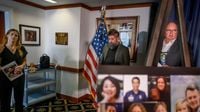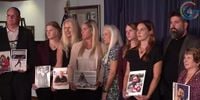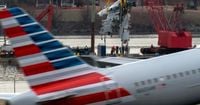On January 29, 2025, tragedy struck the skies above Washington, D.C., when a midair collision between a commercial airliner and an Army Black Hawk helicopter claimed the lives of 67 people. Now, nearly eight months later, the families of those lost are seeking justice and accountability, launching a high-profile lawsuit that could reshape the landscape of U.S. aviation safety.
Rachel Crafton, the widow of Casey Crafton—a devoted husband, father, and aviation professional—filed the first federal lawsuit on September 24, 2025. The suit targets American Airlines, its regional partner PSA Airlines, the Federal Aviation Administration (FAA), and the U.S. Army, alleging wrongful death and negligence. According to The Associated Press and CNN, this is just the beginning: over 60 additional families are expected to join in what may become one of the most significant aviation lawsuits in recent memory.
“It was predictable, it was preventable, and it caused the needless loss of 67 lives,” attorney Bob Clifford, representing the Crafton family and many others, declared at a press conference in Washington, D.C. Clifford emphasized that the defendants “utterly failed in their responsibilities to the traveling public,” referencing a litany of documented near misses and ignored warnings in the years leading up to the disaster.
Flight 5342, operated by PSA Airlines as American Eagle, was on a routine approach to Ronald Reagan Washington National Airport when disaster struck. The Army helicopter, flying above the published 200-foot altitude limit, collided with the jet over the Potomac River. The National Transportation Safety Board (NTSB) later found the helicopter was flying 80 to 100 feet higher than its altimeter indicated, and the route it followed offered only a scant 75 feet of separation from planes landing on the airport’s secondary runway.
The NTSB’s investigation is ongoing and its final report is not expected until 2026. However, the agency has already highlighted multiple contributing factors. Among the most damning: the FAA’s failure to recognize an alarming pattern of close calls—over 30 documented near misses—and more than 15,000 “near miss events” at the airport between 2021 and 2024. Investigators also noted that overworked air traffic controllers were routinely squeezing as many planes as possible into landing patterns with minimal separation, a practice that left little margin for error.
The lawsuit alleges that American Airlines and PSA Airlines failed to adequately train their pilots to handle the risks of close-flying helicopters and allowed risky operational policies, such as scheduling heavy flights late in the hour and accepting intersecting runways. The suit also claims the airlines ignored thousands of reports of congestion between commercial and military aircraft at Reagan National, a charge echoed by attorney Clifford: “There is clear evidence that there were dozens of near-misses and thousands of reports of congestion… that were being ignored by the airlines.”
On the night of the crash, PSA pilots received an alert about the nearby helicopter 19 seconds before the collision but delayed evasive action. The pilots’ warning system showed the direction and altitude of the helicopter, and while controllers warned the Army crew about the jet, they did not warn the PSA pilots directly. The lawsuit contends these failures, combined with systemic issues, set the stage for disaster.
American Airlines and PSA Airlines have publicly defended their actions, stating they “will fight any allegation that they caused or contributed to the collision.” In a statement, the airlines insisted, “Flight 5342 was on a routine approach to DCA (Ronald Reagan Washington National Airport) when the Army helicopter—that was above the published helicopter route altitude—collided with it. American has a strong track record of putting the safety of our customers and team members above everything else.”
The Army declined to discuss the specifics of the lawsuit, stating its focus remains on supporting families and ensuring safety. The FAA, meanwhile, highlighted measures taken since the accident, including restricting helicopter flights around Reagan National and changing air traffic control procedures to eliminate mixed helicopter and airplane traffic. “Our hearts go out to the families who lost loved ones on that tragic January evening,” the FAA said, pledging to continue working with the NTSB “to ensure no family has to suffer this pain again.”
For the families, these assurances ring hollow. The sense of betrayal and loss is palpable. “Nearly eight months ago, our lives were shattered in a moment, and the grief has been unimaginable. The future we dreamed about was taken away from us,” Rachael Crafton wrote in a statement read by her brother-in-law. “Casey was betrayed by this system he trusted. We all were.”
The human toll of the crash is staggering. Victims included members of the Skating Club of Boston returning from the 2025 U.S. Figure Skating Championships, hunters, union members, students, parents from Fairfax County, Virginia, and two Chinese nationals. Doug Lane, who lost his wife Christine and 16-year-old son Spencer—a promising figure skater—has joined other families in turning “grief into action.” Lane told reporters, “We collaborated with Congress on critical air safety reforms. We secured a much needed set of oversight investigations into the FAA, and we will not rest until similar investigations are underway into the U.S. Army.”
Bill and Renee Parente, who lost their 34-year-old son Anthony just months before his planned wedding, echoed the call for accountability: “We are on a mission to make sure this doesn’t happen again. We have to live with this for the rest of our lives.”
The lawsuit also shines a spotlight on longstanding regulatory gaps. In July, U.S. lawmakers introduced a bill requiring all aircraft operators to install anti-collision technology and mandating the Army to keep such systems active during flights. Notably, the helicopter involved in the crash was not broadcasting ADS-B tracking data due to a military exemption, a loophole families and safety advocates say must be closed.
As the NTSB continues its investigation—having already convened three days of hearings this summer—families and their attorneys are determined not to let bureaucratic inertia or corporate interests stand in the way of meaningful change. “Nothing will help the healing process more than seeing the negligence, bureaucracy run amuck, and the instances of putting corporate profits over public safety on full display,” Lane said at the press conference.
While the legal battle is just beginning, the message from those left behind is clear: they are united in their pursuit of answers, accountability, and reforms that will ensure no other family endures the pain they now carry. For Rachel Crafton, Doug Lane, Bill and Renee Parente, and dozens of others, the fight is not just about justice for the past, but safety for the future.


